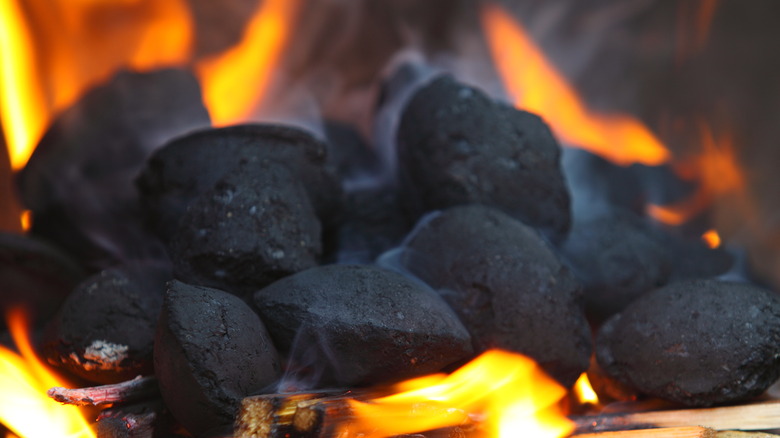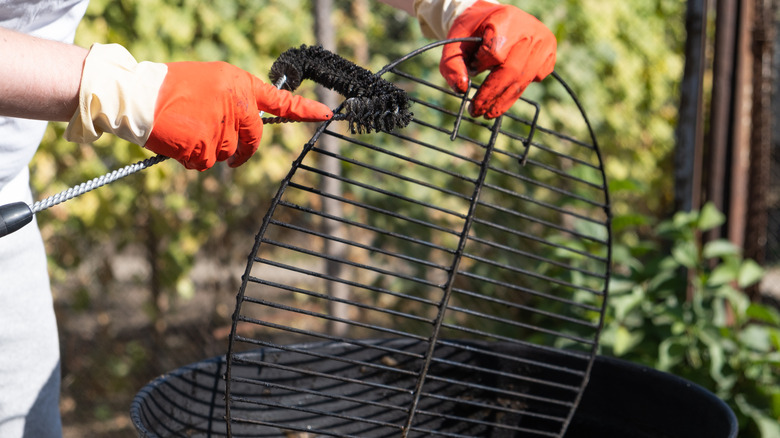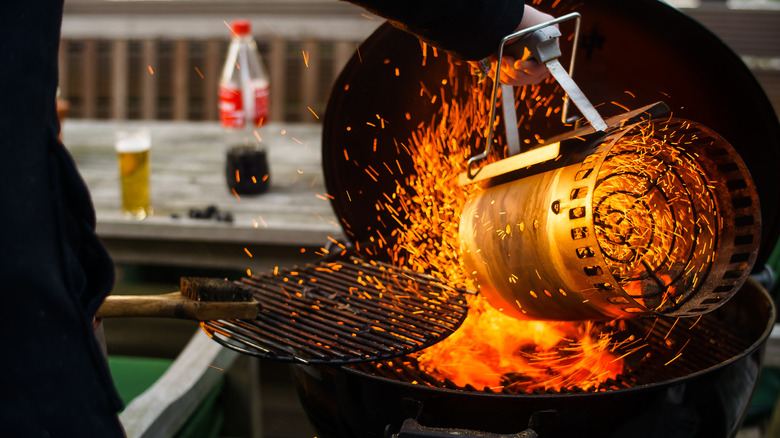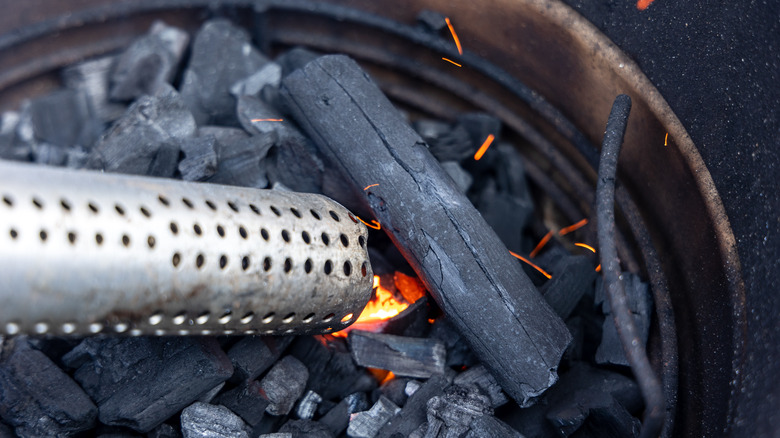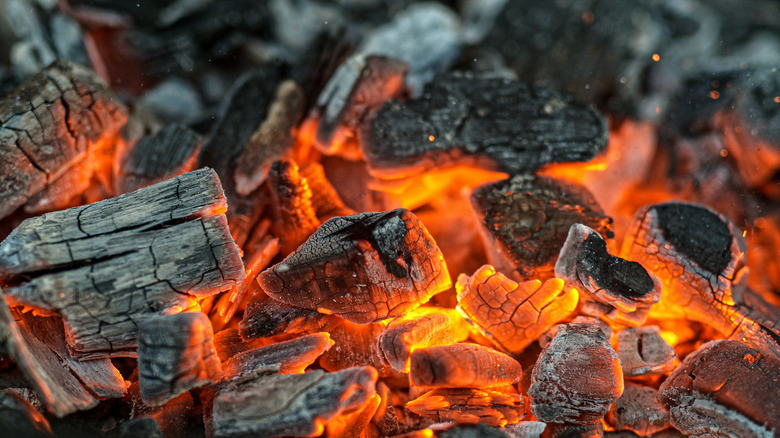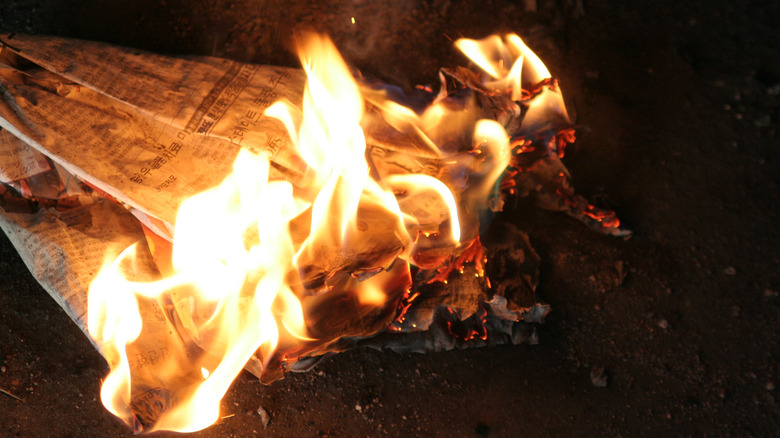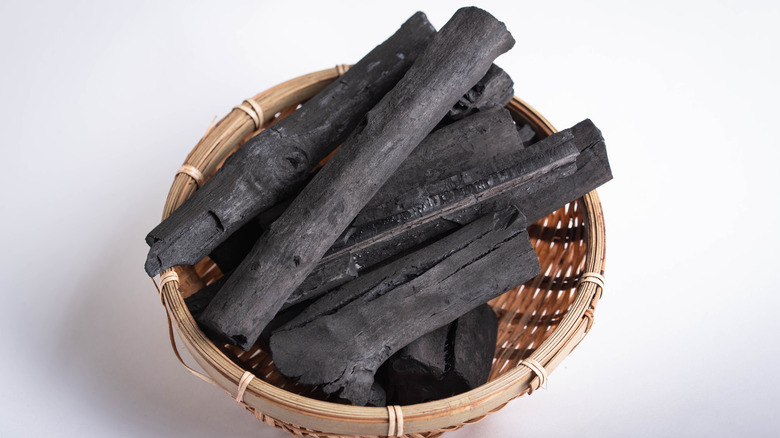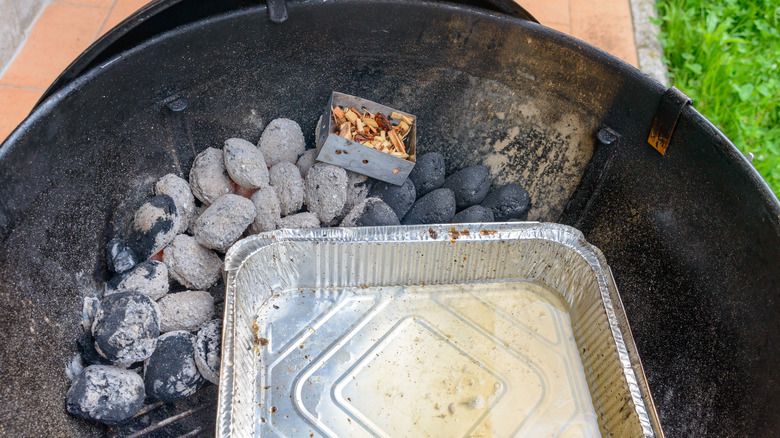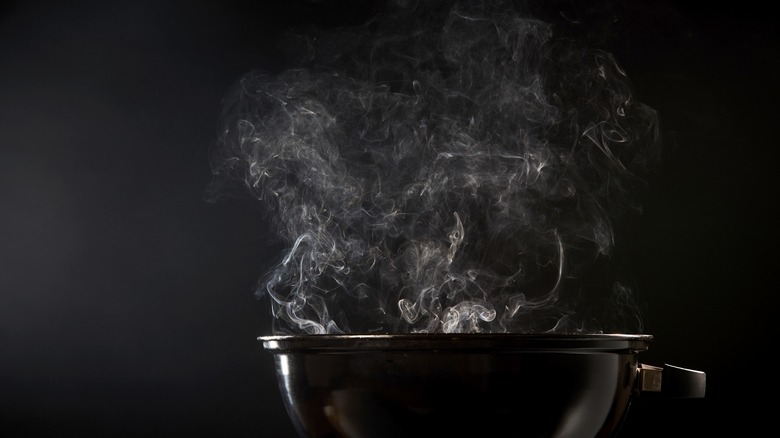10 Tips You Need When Cooking With Charcoal
According to Live Science, we've been using fire for regular cooking from 1.8 million to a mere 300,000 to 400,000 years ago. But despite all that history, many of us could seriously use helpful tips when it comes to cooking with charcoal. From lighting the grill and knowing how varying combustibles can affect our grilling experience to safety tips and the best way to make that burger a perfect medium rare, there are many factors involved.
But we're here to (hopefully) guarantee your success, offering the best tips you need when cooking with charcoal, and many professionals, including BBQ pitmaster Allen LeCuyer, will be on hand to guide us. LeCuyer has been on the competitive backyard-grilling circuit since 2016 and is pitmaster for the BBQ team Magnum PIG. He is a certified judge for the Kansas City BBQ Society and a Minnesota BBQ Society board member. He is the published author of numerous grilling articles, the recipient of multiple grand championship awards, and has won more BBQ competitions than you can shake a rib at. So let's strike a match and get grilling!
1. Start with a clean grill
There are some unspoken but essential rules to social etiquette. Ice cube trays should never be returned to the freezer empty, boxes should be broken up before being thrown in the trash, and grills should be cleaned before lighting. That's a must for any grill-atarian. After all, you aren't going to eat your dinner on dirty plates, are you? There are many ways to clean your grill before and after each use. Grates clean from old grill gunk simply means you'll be tasting this meal and not the previous ones. The often rancid odor from old grease means you'll also enjoy a more pleasant-smelling dish. But it's not just about pleasing the senses. A clean grill can improve your health.
As Healthy Grilling points out, in grills, certain bacteria and carcinogens can build up over time, which can transfer into your food. In addition, dirtier grills have a way of attracting all kinds of food-loving critters like small animals, birds, and bugs. From critters can come fur, feathers, droppings, and every other unwanted hot dog condiment. Because a clean grill can diminish flair-ups, you're now talking about safety benefits as well as an esthetically more pleasing grill for your guests to gather around. So take a few minutes to show that grill some love, and lubricate the grate with a bit of oil to prevent food from sticking.
2. Lose the lighter fluid
Grilling techniques vary as much as opinions on favorite cuts of meats, the tastiest barbecue rubs, and who is the top family griller. But what is rarely debated by pitmasters are the reasons why you should skip the lighter fluid. "Throw your lighter fluid away," Pitmaster Allen LeCuyer demands, "You don't need it, and it can only hurt whatever you're cooking." Anyone who has been around this fire starter knows the distinct smell that comes with it, which is the problem. If the lighter fluid is not completely burned off before the food hits the grate, it will affect the taste of your food, according to LeCuyer.
LeCuyer also notes that some versions of charcoal come with lighter fluid already soaked into the wood, often labeled as "match light" or some other similar name. But lighter fluid is lighter fluid; these marinated briquettes will still have the smell and taste of charcoal you soaked the old-school way. Although match light-style briquettes are easier to start, you'll have the same risk of hurting your meal's flavor as if you added the lighter fluid yourself. As if you needed any other reason to move on from the fire starter, Oregon Metro lists the substance's hazardous ingredients, which can cause anything from skin or eye irritation to lighter fluid poisoning. So keep the family safe and invest in a chimney starter or electric charcoal lighter instead.
3. Use a chimney or electric starter
Our resident expert Allen LeCuyer recommends using a chimney starter, which allows you to heat all the coals evenly and quickly. He instructs us, "When the coals are ready in the chimney, simply dump them into your grill and arrange them ... [so] that the heat dispersion works for what you are cooking." Celebrity chef Bobby Flay echoes LeCuyer's passion for briquettes as he prefers charcoal grills to gas grills; he also recommends using a chimney starter to get the backyard party started.
Another recommendation is an electric charcoal starter. It comes in many styles and also works well for lighting charcoal and protecting the smell and taste of your food. However, an electric source is needed with this method, often requiring an extension cord. Barbehow points out the pros and cons of chimney versus electric starters. In this case, electricity weighs a tad heavier on the negative side, especially for stormy weather thriller grillers. But whichever you choose to use, you're on the right track to a tastier and healthier experience.
4. Let things get hot-hot-hot
Cooking with charcoal can take a bit longer, which is why LeCuyer points out that a successful meal takes patience and that putting food on too early should be avoided. "When coals are getting started, they smoke a lot ... that is not the smoke you want on your food." As charcoal heats up, the smoke they emote becomes cleaner over time — the hotter the coal, the cleaner the process. Although a really smoky grill might speak to your inner troglodyte, Texas Monthly tells us to avoid "dirty smoke" to save the flavor and avoid any "ashtray" tastes. Putting food on early can also affect your outcome. Coal that isn't quite ready will not be as hot. "This can make cooking your food a little more difficult because the temperature of the grill is fluctuating," LeCuyer adds. So, how long is long enough?
Giving your grill plenty of heat-up time ranks high on Wolfgang Puck's essential charcoal grilling tips, recommending lighting the charcoal at least one hour before grilling. This ensures a piping hot grill and that you're not charring your meat or vegetables over flames. If the Corona beer is flowing and the yacht rock music is streaming, you might lose track of time, so we prefer LeCuyer's more straightforward timing technique. "Coals are ready when there is at least some white on all the coal ... you have any that are still completely black, wait a little longer."
5. Use alternate lighting materials
Let's say you take an impromptu stop in the park or decide to gather the gang for a last-minute tailgate party. You have the meats, the veggies, and the charcoal, but there's no chimney or electric lighter to be had. Don't panic! There are options to get you out of a tight spot and maybe even earn you the title of "Barbecue Hero." Lakeside Smokers knows the do's and don'ts to light charcoal without a chimney or electric starter. Lighting bits of paper towel soaked in cooking oil can work (and we know you have cooking oil to give that grill grate the love it deserves). Newspaper is also a popular go-to. However, newspaper has its downsides, including the possibility of burning pieces floating in the air and a slight chance of ink residue getting into your food.
Paper towels soaked in whiskey are an option since whiskey has a high alcohol and sugar content, making it highly flammable. Unlike lighter fluid, whiskey can give off a pleasant odor and even enhance the flavor of your steaks. In fact, if you have some whiskey, Grill Experience recommends using it as a marinade and for grill pairings, but that's for another article. The downside of using whiskey is that the user may have imbibed it. Using this substance for grilling should be done very carefully and with moderation. No fire-breathing Gene Simmons impersonators, please.
6. Find and create hot spots
Have you ever wondered why the hamburger patty on the right is searing away while the burger next to it is taking forever? When this happens, what do we do? We slam the spatula down on that patty like a sumo wrestler pinning a tenth grader and let the flames flare up. Wrong move! We need to embrace our inner hot spots. Some gas grills naturally have "hot spots" where certain areas cook faster than others. This goes the same when grilling with charcoal. There's a simple way to find your grill's hot spots using a loaf of sliced white bread. Simply let the BBQ pit get hot, lay those slices around the grates, and cover. After two minutes, flip the bread over to see which pieces are browner than others. It ain't rocket science, but it works. A waste of bread? Perhaps, but at least you didn't burn an expensive steak.
You can create hot spots with charcoal. By dumping most of the hot coals in the center and leaving the exterior with less, you can now sear some of your food in one place and do a slow cook in another. Consumer Reports recommends building a "two-zone fire" for just this purpose. Arranging all the hot coals on only one side of the grill is an effective way to cook fatter steaks at the same time as thin ones without having to time when they're added.
7. Grill with lump charcoal
Lump charcoal is the way to go if you're into "natural" barbecuing. All charcoal is essentially carbon made from wood burned with little oxygen. But unlike briquettes, it has no fillers or additives and contains less carbon. It also happens to burn hotter and leaves less ash. But as Smoked BBQ Source points out, when weighing lump charcoal versus briquettes, that's one of the negatives. The former burns hotter, which means it burns faster. It also happens to be more expensive. Another issue is that the size of the charcoal in any given bag can range quite a bit, which makes it a bit more awkward to deal with and can create temperature changes compared to a smoother surface of even-sized briquettes. But if you want to enhance your experience, burning over real, all-natural wood is pretty awesome.
In an interview with NPR about the great charcoal debate, Craig "Meathead" Goldwyn, featured author on Amazingribs.com, believes that lump charcoal is growing in popularity "as just an extension of the organic movement." Lump charcoal is purer and is typically marketed as a "natural" product, and as Meathead points out, "It reflects on the public's desire to have less stuff in their food and their cooking." And let's face it, if a grill expert is "all in" enough to call himself Meathead, we'll take his word for it.
8. Binge with binchotan
Binchotan is a Japanese charcoal that burns very clean and is virtually smoke-free, making it popular for chefs in Japanese kitchens or grillers living in tiny New York City apartments. As Korin points out, white binchotan is most popular for these applications as it is scentless, smokeless, and burns very hot, getting the job done quickly. Executive chef Thach Tran of Ace in Denver, Colorado grills with a blend of binchotan and mesquite charcoal because the high heat source caramelizes his meat and vegetables before burning them, as listed on Famous Chaps' BBQ grilling tips from celebrity chefs.
Like lump charcoal, it is also an all-natural, no additives product. In fact, binchotan (which has a literal translation of "charcoal") has many other uses outside the grill. Nourished Life celebrates its organic benefits, ranging from water and air purifier to plaque remover and teeth whitener. It even fosters "good energy." Now, as you can infer from learning about binchotan, it has one serious downside: price. If you're looking to purchase binchotan for your grill, you'll need deep pockets, but the grill cred you'll get from family and friends might be worth the yen.
9. Turn your charcoal grill into a smoker
Smoker? We don't need no stinking smoker! If you have a grill, some briquettes, a bit of wood, and a water pan, you can turn your charcoal grill into a smoker. The technique is called "the snake method," According to Popular Mechanics, it will effectively smoke your meat, fish, and vegetables without having to shell out hundreds of dollars for a designated smoker. The trick is to avoid direct heat when cooking. How does one achieve this? Enter the snake...
Essentially you construct a line (or "snake") of briquettes in a semi-circle on one side of the grill's lower grate. Then you're going to double it, following along that same semi-circle with more charcoal. Then build two more snakes of briquettes on top of those two. When you stand back, it should look like your grill is smiling at you (it is). Get four or five small hunks of wood or a handful of wood splinters in a metal box, and place it atop the briquettes for flavor. When lighting, it's helpful to have a few paraffin fire starter cubes in your chimney and only about ten briquettes. While waiting for the charcoal to heat, place a disposable foil water pan three-quarters full of water on the grate next to the snake to keep a steady temperature and add moisture for the meat or fish to cook in. Voila! You're smokin' now.
10. Put out and dispose of charcoal properly
We've had a fun and successful day of barbecuing together, so after the marshmallows have been properly toasted, let's be sure that we end this picnic responsibly and safely by exploring the safest way to put out a charcoal grill. First, clean the grates for the next grilling session while the grill is still hot. As for any remaining charcoal and embers, do we dump a bucket of water on the hot coals to alert the folks two counties away that our picnic is over? No, we do not. Nor do we tip our grill backward into the kid's sandbox. We simply cover the grill, close the vent holes, and let it burn out and cool, waiting for about 48 hours. Not so much fun, but a heck of a lot safer.
If you're grilling on the go, like at a picnic area or a tailgate party, and you have to get going faster, remember, fire needs oxygen, so the sooner you can cover the grill and shut those vents, the better. Once the grill has cooled, the Hearth, Patio, and Barbecue Association recommends spreading out aluminum foil and carefully placing the used charcoal on the foil, using tongs, of course. From there, dump the foil into a metal garbage can free of combustibles. Thank you for cooking responsibly, and as they say in the grilling world, "Relish today, you can always ketchup tomorrow."
